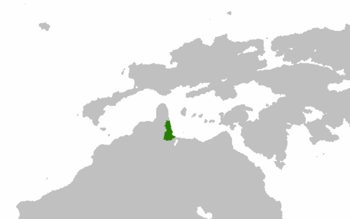Limonaia
The Grand Duchy of Limonaia Il Granducato di Limonaia | |
|---|---|
| Motto: "Nobiscum Deus" "God with us" | |
| Anthem: Alzati, figli della Limonaia! (Arise, Children of Limonaia) | |
 Limonaia in Northern Alharu | |
| Capital and largest city | Limone |
| Official languages | Cristinese |
| Recognised national languages | Variot |
| Ethnic groups (2017) | Limonaians (96,3%) Variotans (1,7%) Other (2%) |
| Demonym(s) | Limonaian |
| Government | Semi-Constitutional Parliamentary Unitary Monarchy |
• Grand Duchess | Margherita Desiderata I |
• Prime Minister | Giuliano Saleri |
| Formation | |
• Establishment of first Republics | March 1489 |
• Unifcation into Grand Duchy | 29 July 1694 |
• Elevation to Kingdom | 17 November 1745 |
• Limonaian Civil War | 11 March 1902 |
• Constitutional Monarchy Established | 2 October 1902 |
• Monarchy overthrown Republic Established | 7 July 1952 |
• Monarchy Restored | 10 March 1976 |
• New Constitution | 22 January 1982 |
| Area | |
• Total | 80,994 km2 (31,272 sq mi) |
| Population | |
• 2017 census | 48,102,000 |
• Density | 594/km2 (1,538.5/sq mi) |
| GDP (PPP) | 2017 estimate |
• Total | $1,633.9 billion |
• Per capita | 33,969 |
| GDP (nominal) | 2017 estimate |
• Total | $1,180.5 billion |
• Per capita | 24,541 |
| Gini (2017) | high |
| HDI (2017) | very high |
| Currency | Limonaian Lira (LLR) |
| Time zone | UTC-5 (Alharun Central Time) |
| Date format | dd/mm/yyyy (AD) |
| Driving side | left |
| Calling code | +47 |
| ISO 3166 code | LI |
Limonaia, officially the Grand Duchy of Limonaia (Cristinese: Granducato di Limonaia) is a country in Northern Alharu. Located next to the Ygros sea, and Sakspati sea, Limonaia shares land borders with Soreana and a maritime border with Valacia. Limonaia covers an area of 80,994 km2 (31,271.9 sq mi) and has a largely temperate seasonal and Mediterranean climate. With around 48 million inhabitants, it is the second-most populous, and most densely populated country in Alharu.
Its geographical position in the middle of the Alhargic seas made it an attractive area for the settlement of various early civilisations including the Akemar who inhabitied the northern areas of modern day Limonaia. As well as the Akkar and Geraya in modern day Celino and Anacone respectively. The Akemari city of Nuqi would united the Akermari civilizations into the Nuqi empire which would expand to encompass most of Limonaia. After years of decline and constant slave rebellions, the arrival of Europan settlers from Cristina acted as the final blow to the Kingdom, which collapsed and was mostly absorbed by the Cristinese, who during the 13th century would bring an increasing ammount of workers and settlers to the various independent colonies that formed along the coast.
With a steady influx of settlers from Europa, various City-states and maritime republics were established along the Ygros sea and competed for resources and trade in the region, which was funneled back to the Europan homeland. These wealthy cities would fund expeditions in order to discover new resources to outcompete their rivaling neighbours, which led to a rapid succession of new settlements and outposts being established in both Alharu and Argis. Corruption and political instability lead to the majority of the city-states becoming monarchies. The Duchy of Limone would eventually unite the country in 1694 proclaiming the Grand Duchy of Limonaia, and in 1745 the Kingdom of Limonaia. With help from their previous colonial outposts Limonaia quickly grew into a colonial empire with colonies on Argis, Alharu and Aurelia providing great wealth to the country. Unrest following the abuse of power by the King lead to the Limonaian Civil War which lead to the collapse of the Limonaian Empire and the collapse of the Kingdom. Large portion of Limonaia proper broke off and forced King Umberto III to abdicate in favour of his brother, who was forced to accept a liberal consitution limiting the monarchy's power. Unhappiness with the collapse of the empire lead to a fascist coup in 1952, which established the Republic of Limonaia lasting til 1976 where the monarchy was restored whith near dictatorial powers. In the following decades, Limonaia has slowly liberalized once more, with parliament reopening in 1982.
Modern day Limonaia is a nation with huge societal struggles, especially due huge wealth inequality and issues with corruption. The country maintains a strong and diverse economy, but struggles with controlling monopolies within certain sectors. Limonaia is a member of ATARA.
Etymology
WIP
Geography
WIP
Government
WIP This template may be deleted.

